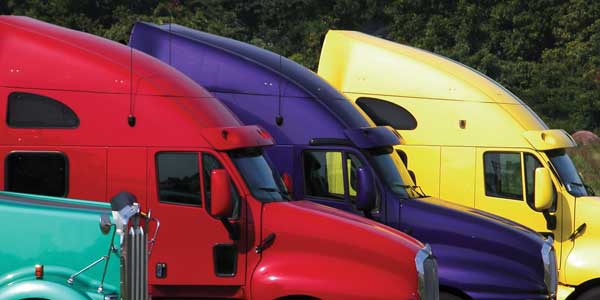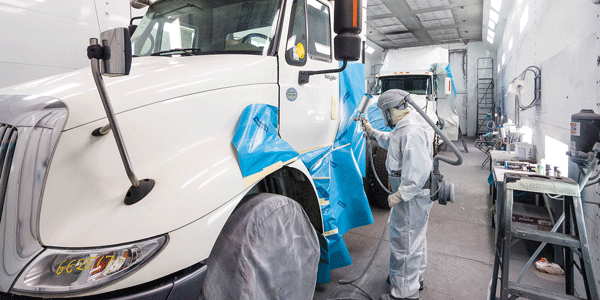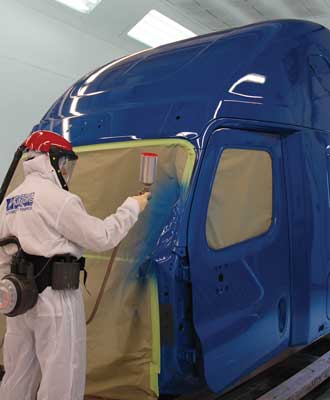Today’s truck components are infused with the latest technology and advanced features, and the paints and finishes that coat your truck are no exception. According to J.J. Wirth, brand manager of the fleet segment for the U.S. and Canada with PPG, the three major areas that have seen the latest advancements and formulations are corrosion protection, low volatile organic compounds (VOCs) characteristics and enhanced productivity. Let’s start with corrosion protection.
Corrosion protection
“Coatings that offer effective corrosion resistance help protect fleet assets and extend their working life,” Wirth said. “Corrosion resistant coatings fight the elements—such as road salt, dust and dirt—that can negatively affect vehicle structural integrity, especially the undercarriage, and lead to expensive repairs and costly downtimes. PPG coating products have been developed to protect all types of vehicle substrates including aluminum, steel, composites and plastics.”
According to Dan Szczepanik, transportation marketing director for Sherwin-Williams, a protective coating can pay for itself in length of service, reduction of maintenance expenses over the life of the vehicle and retention of your trademark color and gloss.
“A relatively small increase in the price of a premium coating can save you tenfold over the life of the vehicle,” he said. “But low-performance coatings cause premature corrosion, units out of service for repair and lower resale value of the unit.”
Clearly, when considering coatings, you have to ensure that you’re going to get the proper protection for your operation. If you’re in climates that experience harsh winters, you’re going to want protection from salt and other de-icing mixtures. If your trucks are rolling through blazing, dry desert environments, you’ll want to ensure the proper UV protection.
“Any season can wreak havoc, but the winter and summer months stand out above the rest. This is not only what occurs to the vehicle when it is traveling, but also because the chemical reaction that takes place during the paint process during these seasons. For instance, they also can move from one extreme to the other,” said Kyle Hauenstein, product manager with Martin Senour. “For example, summer months in Texas or Arizona can speed up the chemical reaction extremely fast while winter months in Minnesota or the Dakotas can slow the reaction down too much. These extreme ends of the spectrum can be problematic during the paint process.”
Robert Tsas, sales segment manager with AkzoNobel, noted that the most important thing is to think about the value of a coating in a detailed and deliberate way. “Will paying more for a protective coating require less maintenance?” he asked, highlighting questions to answer as you make your paint decisions. “Will the color or design add to your brand value? How long do you keep the vehicles, and will de-imaging cost impact residual bale significantly? Then decide based on the value to your business.”
Given that every fleet application has its own specific operational nuances, nailing down your paint and coating ROI can be difficult.
“There is no absolute formula for measuring coating ROI. The best way to try and gauge ROI may be simply to compute the cost of the coatings and any corrosion repairs with the resale value of the vehicle,” PPG’s Wirth recommended. “In the case of three- to five-year leases commonly used by fleets, effective coatings may minimize wear and tear on truck bodies, enhance their appearance and prevent add-on lease costs. Comparisons of cost and resale over several years should give a fleet manager a clear picture of the value of the coatings.”
Low VOC
Lowering VOCs has been a key initiative within the paint and finish segment and paint companies continue to drive the amount of VOCs in its paint. Because of environmental concerns, low-VOC standards are in place across the United States and Canada. Compliance standards vary from region to region.
“This is an ongoing process that focuses on innovative formulations that address low-VOC concerns while delivering high-quality results,” PPG’s Wirth said. “Since VOC standards vary from region to region, we work to meet the strictest standards. Consequently, products like our 2.1 low-VOC primers and clearcoats are compliant with all parts of the United States and Canada.”
Sherwin-Williams’ Szczepanik explained that the company’s goal was to create low VOC offerings in which the fleet would not notice any change in application, cure or appearance. “We utilize high solids, waterborne technology and compliant solvents to lower volatile organic compounds. In our arsenal of low VOC coatings we offer 0.5 lbs./gal. direct to metal primers and 0.5 lbs./gal. high gloss single stage topcoats. We want to stay ahead of regulations.”
Enhanced productivity
There are two particular aspects of a truck’s paint and finish that can help keep them rolling productively. The first, however, requires a helping hand. While protective coatings can help extend the life of your truck, they’re not a replacement for preventative maintenance. Staying focused on the finish during your PM schedule will help you avoid costly downtime due to corrosion.
“Like anything in operation, regular attention and maintenance help improve the long term performance,” Szczepanik advised. “If you operate in San Diego, these can be monthly. If you operate in Buffalo, these can be weekly or more. Operating environment does make a difference and can lengthen or shorten the life span of the coating.”
And though it might be too obvious to state, washing your trucks regularly is the most effective way to protect the finish. Some tips:
- Use cold or tepid water and a mild, non-abrasive detergent or soap that is intended for washing vehicles.
- Never use abrasive cleaners, scuff pads, sand paper, harsh chemicals, or steel wool directly on the finish to remove contaminants such as road tar.
- All cleaning agents should be rinsed from the surface immediately after washing and not allowed to dry on the paint.
- Never wash the vehicle in the direct rays of the sun or use hot water, strong soap, or chemical cleaners. Doing so may cause the paint surfaces to become spotted, streaked, or damaged.
- If using a high-pressure washer, be sure the wand tip is several feet away from the vehicle to avoid damage to the paint. Also, the maximum pressure should not exceed 250 PSI.
- Repair any breaks in the paint film that result from accidents, stone chips, etc. to prevent corrosion from occurring.
The second finish-focused productivity area is the paint’s properties that enable a quick fix when one is needed.
“Fleets need to keep their vehicles moving and avoid tying them up with complex or lengthy refinish processes,” PPG’s Wirth said. “Coatings that offer fast bake times and dry speeds, are easy to use, and allow a quicker overall refinish pace to minimize downtime are obviously preferable.”
The finish line
Don’t think that the finish doesn’t matter when the truck comes to the end of its lifecycle. Keeping the truck’s finish in tip-top shape can help improve its resale value. Even if the secondary buyer is going to repaint the truck, making sure the truck’s paint is intact will indicate that the underlying substrate is intact and also in good condition, raising the resale value, Szczepanik noted.
“Usually, a vehicle’s appearance indicates the truck has been well-cared for,” Wirth said. “While most fleets don’t repaint vehicles if they’re on leases, fresh or well-maintained paint is a factor for all fleet vehicles, whether they are leased or owned by the fleet or owner-operator trucking enterprises. Think about your personal vehicle and how you detail it before selling it or turning it in when the lease expires. It’s the same thing for a truck: better paint means better resale.”
For more on paints and finishes, read the pros and cons of powder and liquid coatings here.
















